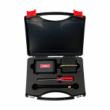What is it?
Birth Alarm
The horse: totally at ease with man and a cherished domestic animal.
Surprisingly though, a mare in foal will display protective instincts that go far deeper than the bond between her and keeper. Her delivery is a time when she feels vulnerable and unless she is totally at ease, it is suspected that she can actually delay the birth until she feels that she will not be disturbed.
In consequence, signals that the delivery is about to happen can be barely discernable or even absent.
However, research has shown that during her contractions the mare will lie down totally on her flanks. In this totally lateral position she is able to gauge each contraction and control the final expulsive phase of the delivery.
Birth Alarm works by utilising this physiological phenomenon.
Birth alarm is a very reliable system and a very simple and horse-friendly system. Since the introduction of this patented system in 1990, the best breeders have put their trust in this system, which is known far and wide. Now there is also a Birth alarm with GSM technology available, making the system more user-friendly than ever.
Birth Alarm ![]() What is it?
What is it?
| Birth Alarm consists of a transmitter and a receiver. The transmitter is attached to an antiroll girth which is placed around the horse’s withers. The mare experiences no discomfort whatsoever from the leather girth. You set the receiver in the desired place, for example in the bedroom, and plug it in. A 12 volt adapter is available for isolated locations. Not always at home? Connecting the Birth Alarm telephone selector allows the receiver to call you at the number where you are available. The latest models of Birth Alarm are fitted with a control function for testing the battery in the sender and if the transmission signal is being received properly. This version is recognisable by the green label on the back of the sender and the receiver. The transmitter has a range of 1km, with the aid of a mobile telephone dialler.
Innovation 2006: Birth Alarm GSM |
|



